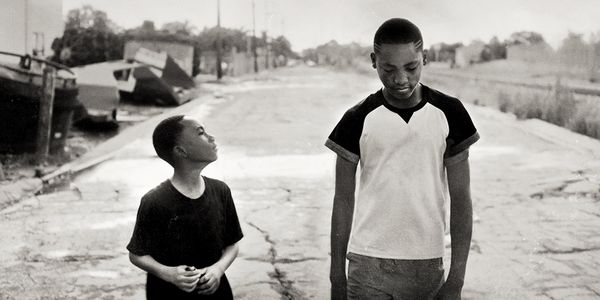Toronto International Film Festival 2018 Report Part 2: Fame (And Fabric) Monsters

Tomas is a chronic cineaste who studied English literature in…
The Toronto International Film Festival is still in swing, and as I am not dead from exhaustion (yet), here are my reviews of the four films I saw on the second day of the festival:
Birds of Passage (Cristina Gallego & Ciro Guerra)

Films about the drug trade are a territory I am not especially familiar with. I don’t have an especial affinity for their seedy subject matter, which inevitably includes copious amounts of violence involving guns. Look, nine times out of ten, I flinch whenever a gun is fired in a film – especially when it’s done without warning. Sometimes I have to grit my teeth and wait for that unpleasant blast to emanate from the sound system before I can breathe properly again. I’m not a person who takes well to guns, let’s put it that way.
There is a lot of gun violence in Cristina Gallego and Ciro Guerra’s Birds of Passage, and yes, I flinched a few times. What surprised me, though, was how sensibly it was put together. This is certainly not your typical drug crime thriller, where racist caricatures swagger around like oversized villains while white redeemers try to save the day. The genre’s racist trappings are instead deconstructed into something postcolonial, pinning the blame for a Columbian tribe’s descent into corruption on white caricatures: Peace Corps volunteers who espouse the tenets of capitalism and love a good toke of marijuana. It’s almost comical how innocuously they appear when introduced, and yet their influence becomes destructive once the Wayuu clan becomes ensnared in dangerous drug deals that put everyone’s life on the line.
The film is sectioned off into five acts, which are called “songs” by the filmmakers; each one covers a different time period in what amounts to high tragedy at the end of the day, building gradually into an operatic climax that leaves bodies on the floor and uncertain futures for the few survivors. Gallego and Guerra calibrate the rising tensions with a skillful deliberation, allowing the audience to soak in the Wayuu way of life, their customs, and their superstitions before each is slowly desecrated by the pride and avarice ushered in by the cartels.
Without this kind of world-building, the film would’ve welcomed too many uneasy assumptions about the power dynamics between the indigenous tribe and the cartel bosses, and the subsequent power of its theatrical scope would’ve been lost. But by keeping our sightlines solely on the indigenous tribe’s culture, we come to appreciate the story from their perspective, without the threat of a colonizing gaze seeking to distract us.
If there is a flaw in all this, it’s that the film lacks spontaneity. Once you realize that the structure has a predestined quality to it, it does feel like Gallego and Guerra are steering their ship to harbor in a rote fashion. The timeline is kept strictly chronological, and events are dutifully foreshadowed before they occur. The dryness of their approach is somewhat at odds with its postcolonial impetus, but it’s also not glaring enough to make it a chore. There’s enough indigenous beauty on display, and a prevailing tension of impending doom to round it off nicely.
Vox Lux (Brady Corbet)

You can chalk up Vox Lux in one handy word: abrasive. From the opening prologue, which catapults us into the triggering aftermath of a school shooting with very little warning, to the final epilogue, wherein a series of deliberately tinny and shallow pop trifles are sung half-convincingly by Natalie Portman, Brady Corbet makes no attempt to make his directorial follow-up an accessible ride for ordinary audience members. A Star is Born it’s decidedly not; in fact, one could see it as a poisonous valentine to such films, stripping away the gloss of pop superstardom to reveal its ugliest facade. What results is a fascinating and ridiculously ambitious film in its own right.
Framed as a patchwork fable of tonal incongruity (which, believe it or not, is a compliment), and complete with ominous narration from Willem Dafoe as though the film were a grander extension of Behind the Music, Vox Lux chronicles the life of Celeste Montgomery, who was injured in the school shooting mentioned previously and becomes a sensation when she sings an original tune during a vigil for the victims. The success of the song prompts her to pursue a musical career, which she does alongside her sister (Stacy Martin) and blunt manager (Jude Law). The striking Raffey Cassidy plays the young Celeste (and, later, in a smart bit of cyclical continuity, Celeste’s own daughter) with calm assurance and a mischievous twinkle when she discovers the pleasures of the party scene, slowly shedding her Sunday school wholesomeness for something much wickeder.
In the second act, we enter 2017: Portman’s segment. And boy, what a segment. Decked out in leather and tights, chomping down hard on a New York accent, and pointing her carefully manicured nails at every living soul she meets, Portman’s version of Celeste is a hellish vision of corrupt decadence and unresolved traumas. “Hot mess” doesn’t come close to what we’re dealing with. More like “the embodiment of a living Hell.” Admittedly, it does take a moment to adjust to Portman’s performance, as it’s so unlike anything she’s ever done, but after you watch her snarl and flail for a few minutes, she rivets you to the spot. And what’s more, her broadness jives well with the portrait Corbet paints of the character, which is bleaker than bleak. It may be funny at first to see Portman like this, but soon the laughter quiets to a hushed kind of terror when the true extent of her breakdown is made clear.
It’s a breakdown precipitated, after all, by the commodification of trauma, and the perverse ways in which trauma can commodify us in turn. Corbet makes it clear that Celeste’s fame lies solely in the way in which she takes advantage of a violent incident, and that fame spirals into such degraded pastiche because the festering guilt of having co-opted this trauma has taken her both body and soul. This idea is brought into greater relief when terrorists wearing her branded masks commit an atrocity on a public beach on the day of her hometown concert. It’s a literal representation of way trauma and commodities intersect here, and Celeste’s conflicted response is even more telling of the responsibility she bears as the by-product of vicarious violence. Victim and villain all in one., and yet there is no reducing her to either one or the other. Such is the power of her character.
It goes without saying that Vox Lux is a challenging text all around, and that “having a good time” is the least of its concerns. Even so, the glut of this work’s acerbity, as well as the pugnacious tenacity of Corbet’s vision, lends it a staying power unlike any other. You just have to physically stay in your seat until the conclusion for that to happen, which for some will prove to be an endurance test.
What You Gonna Do When the World’s on Fire? (Roberto Minervini)

On paper, it perplexes me that a white Italian man would be the best candidate to shoot a documentary about Black American lives, he being neither Black nor a naturalized American (though he does live there occasionally). I worried that Minervini’s foreignness (relative to his subjects) would breed an unwelcome distancing effect, pushing us further away from the people he was filming rather than getting us close to them.
I still don’t think he gets away with it entirely, as there are a few moments in What You Gonna Do When the World’s on Fire? where slivers of detachment are exposed. This is particularly apparent when the film cuts away to the Big Chief of Mardi Gras, whose subtle work of cultural preservation does not engender the same level of intimacy as, say, Judy Hill’s tenacious fight for her jazz bar, or Ronaldo and Titus’ innocence romps around their crime-riddled neighborhood. Not every shift in perspective contains the magic Minervini was hoping for, though overall I’d still say the film succeeds in empowering its subjects, and thus becomes a powerful testament in itself.
In weaving between different people and different geographical regions, What You Gonna Do structures its empathetic mode on ideas of kinship and racial solidarity, pinpointing the trials of different subsets of Black America and finding the common ties that bind them together spiritually. I’d like to think that Minervini’s decision to shoot in black and white touches upon the spiritual aspect specifically, as the compositions here are bathed in almost angelic hues.
When Minervini utilizes close-ups, this angelic aura almost baptizes the subjects and brings them into a new state of being, emphasizing their strength of character and tireless resistance to the discriminatory structures that pervade their livelihoods. Again, it can sometimes come across awkwardly because of Minervini’s race, but his insistence on allowing these people to give voice to their inner souls shows that his heart is in the right place. If anything comes across patronizingly, it’s not intentional.
Indeed, a film that freely shows the New Black Panthers feeding the homeless in their community and crusading against police brutality cannot be said to be patronizing. Nor could it be seen as patronizing when a woman lays bare the demons that haunt her, recounting her childhood abuse and drug addictions as a way of consoling a fellow sufferer. These moments, and many others, are suffused with a kind of enraptured attentiveness, as though the camera were physically leaning in to hear these people talk (and, by talking, become empowered).
This is where Minervini excels: he neither intervenes nor disrupts. His subjective documentation lies in respecting the fluxes and fissures of these lives, which are liable to change at a moment’s notice. His role is to capture a fleeting glimpse of lives lived on the margins, and then to knit together those margins until they are no longer peripheral. It may be that he does this imperfectly, but it ought to be said that his efforts have created an extremely moving and rousing portrait of Black America that will not soon be easily replicated.
In Fabric (Peter Strickland)

I am tempted to write this review in the ornate circumlocution of Dentley & Soper’s sales assistants, who mystify their customers by threading together sentences that sound more like horoscope readings than everyday conversation. But I will not, because you will find it insufferable – and maybe, by extension, think the film insufferable, too. I can assure with confidence that it is not. In fact, it is sure to prove Peter Strickland’s most accessible work to date, due in part to its inherent and unabashed wackiness, which had my screening light up with laughter on numerous occasions. Its unique take on fetishistic consumerism, where the eeriest of stores can still attract mountains of customers all because of bang-on bargains, may not be particularly incisive, but there’s so much madcap fun to be had that it doesn’t end up mattering much. There’s still a smashingly good time to be had by all, and yet another successful endeavor for Strickland (who is now one of my most favorite filmmakers working today).
The menacing centerpiece of In Fabric is a striking red dress with a life of its own and a tragic history (the woman who modeled it for a catalogue spread died shortly afterwards, for instance). It is first foisted upon the comely Sheila (Marianne Jean-Baptiste), a bank teller in search of love after divorce. She suspects nothing at first, but when her first date goes terribly, and her washing machine goes berserk with the dress inside it, she begins to be suspicious of its powers. No matter how often she tries to rid herself of her haunted threads, though, they keep coming back.
When the dress finally does leave her through circumstances I’m not at liberty to reveal, it finds itself in the possession of a nebbish repairman named Reg (Leo Bill) – and that’s when the insidious cycle of bad luck and mysterious skin rashes begins all over again, this time plaguing a male owner rather than a female one. And all the while, the sinister workers at Dentley & Soper’s beckon in their waiting customers with chiselled grins, surely concocting some villainous schemes in the store’s secret recesses during their lunch breaks. It’s just that kind of movie. Nothing is left off the table.
Visually ravishing thanks to Strickland’s impeccable throwbacks to giallo horror and European erotica (Eurotica?), In Fabric is the kind of pleasurable oddity you’d gladly watch more than once with a group of friends able to appreciate its arch humor, aural sensuality, and sinister detours into the unknown. If it suffers from any major setbacks, it’s in the two-tiered structure that doubles the character list without doing enough to make them three-dimensional.
This could’ve easily been Jean-Baptiste’s film the entire way through without sacrificing the maniacal climax, for as much as Reg’s arc has its charms, it’s decidedly less consistent (and, therefore, less engaging). But I guess showcasing the dress’ destructive power on more than one life was necessary to keep the horror elements in play. After all, what fun is there in a diabolical dress terrorizing only one person? Either that, or there was simply no other way to do the “ASMR vis-a-vis washing machine jargon” gag that highlights the film’s second half.
Yes, indeed, I just said “ASMR vis-a-vis washing machine jargon.” Excited yet?
Toronto International Film Festival: Next Time
If you love Lucas Hedges, you’ll want to stay tuned for my takes on two of his latest films. Plus, Richard Billingham brings his photographic career to life, and Jean-Luc Godard reminds us that he is still very much alive.
Who would you cast in a film about a pop star in decline? Let us know in the comments below!
The Toronto International Film Festival runs from September 6th to the 16th.
Does content like this matter to you?
Become a Member and support film journalism. Unlock access to all of Film Inquiry`s great articles. Join a community of like-minded readers who are passionate about cinema - get access to our private members Network, give back to independent filmmakers, and more.
Tomas is a chronic cineaste who studied English literature in university (in both the undergraduate and graduate levels), and hopes to pursue a career in writing. His passion for film began in earnest at the beginning of the 2010s, and since then he's been reveling at the vast horizons of the cinematic landscape like a kid at the proverbial candy store.













